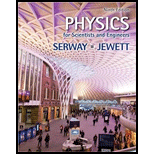
We have seen that a long solenoid produces a uniform magnetic field directed along the axis of a cylindrical region. To produce a uniform magnetic field directed parallel to a diameter of a cylindrical region, however, one can use the saddle coils illustrated in Figure P29.46. The loops are wrapped over a long, somewhat flattened tube. Figure P29.46a shows one wrapping of wire around the tube. This wrapping is continued in this manner until the visible side has many long sections of wire carrying current to the left in Figure P29.46a and the back side has many lengths carrying current to the right. The end view of the tube in Figure P29.46b shows these wires and the currents they carry. By wrapping the wires carefully, the distribution of wires can take the shape suggested in the end view such that the overall current distribution is approximately the superposition of two overlapping, circular cylinders of radius R (shown by the dashed lines) with uniformly distributed current, one toward you and one away from you. The current density J is the same for each cylinder. The center of one cylinder is described by a position vector
Trending nowThis is a popular solution!

Chapter 30 Solutions
PHYSICS 1250 PACKAGE >CI<
- The cube is placed in a bucket of water and find that it floats, with 33% of its volume submerged below the surface of the water. What is the density of the mystery material? The material is uniformly distributed throughout the solid cube, with the number of kg/m3.arrow_forward2.82 A ball is thrown straight up from the ground with speed Up. At the same instant, a second ball is dropped from rest from a height H, directly above the point where the first ball was thrown upward. There is no air resistance. (a) Find the time at which the two balls collide. (b) Find the value of H in terms of un, and g such that at the instant when the balls collide, the first ball is at the highest point of its motion.arrow_forwardThe small piston has an area A1=0.033 m2 and the large piston has an area A2= 4.0 m2. What force F2 will the large piston provide if the small piston is pushed down with a force of 15 Newtons with an answer in Newtons?arrow_forward
- 2.23 BIO Automobile Airbags. The human body can survive an acceleration trauma incident (sudden stop) if the magnitude of the ac- celeration is less than 250 m/s². If you are in an automobile accident with an initial speed of 105 km/h (65 mi/h) and are stopped by an air- bag that inflates from the dashboard, over what minimum distance must the airbag stop you for you to survive the crash?arrow_forwardPlease solve and answer these problems correctly.Thank you!!arrow_forward2.2. In an experiment, a shearwater (a seabird) was taken from its nest, flown 5150 km away, and released. The bird found its way back to its nest 13.5 days after release. If we place the origin at the nest and extend the +x-axis to the release point, what was the bird's average ve- locity in m/s (a) for the return flight and (b) for the whole episode, from leaving the nest to returning?arrow_forward
- Use relevant diagrams where necessary and go through it in detailsarrow_forwardYour blood pressure (usually given in units of "mm of Hg") is a result of the heart muscle pushing on your blood. The left side of the heart creates a pressure of 115 mm Hg by exerting a force directly on the blood over an effective area of 14.5 cm2. What force does it exert to accomplish this? (Give your answer as the number of Newtons and note that you will need to do some unit conversions.)arrow_forwardWhat is the absolute (total) pressure experienced by a diver at a depth of 17 meters below the surface of a lake? Assume that atmospheric pressure at the surface of the lake is 101,000 Pascals, g= 9.8 m/s2, and the density of the water in the lake is 997 kg/m3. Give your answer as the number of Pascals.arrow_forward
- A particular solid cube has an edge of length 0.59 meters and is made of a material whose density is 3500 kg/m3. What is the mass of the cube? Give your answer as the number of kilograms.arrow_forwardSolve and answer correctly please.Thank you!!arrow_forwardA cart on wheels (assume frictionless) with a mass of 20 kg is pulled rightward with a 50N force. What is its acceleration?arrow_forward
 Physics for Scientists and Engineers: Foundations...PhysicsISBN:9781133939146Author:Katz, Debora M.Publisher:Cengage Learning
Physics for Scientists and Engineers: Foundations...PhysicsISBN:9781133939146Author:Katz, Debora M.Publisher:Cengage Learning Physics for Scientists and Engineers with Modern ...PhysicsISBN:9781337553292Author:Raymond A. Serway, John W. JewettPublisher:Cengage Learning
Physics for Scientists and Engineers with Modern ...PhysicsISBN:9781337553292Author:Raymond A. Serway, John W. JewettPublisher:Cengage Learning Physics for Scientists and EngineersPhysicsISBN:9781337553278Author:Raymond A. Serway, John W. JewettPublisher:Cengage Learning
Physics for Scientists and EngineersPhysicsISBN:9781337553278Author:Raymond A. Serway, John W. JewettPublisher:Cengage Learning Principles of Physics: A Calculus-Based TextPhysicsISBN:9781133104261Author:Raymond A. Serway, John W. JewettPublisher:Cengage Learning
Principles of Physics: A Calculus-Based TextPhysicsISBN:9781133104261Author:Raymond A. Serway, John W. JewettPublisher:Cengage Learning Physics for Scientists and Engineers, Technology ...PhysicsISBN:9781305116399Author:Raymond A. Serway, John W. JewettPublisher:Cengage Learning
Physics for Scientists and Engineers, Technology ...PhysicsISBN:9781305116399Author:Raymond A. Serway, John W. JewettPublisher:Cengage Learning





